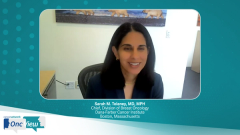
Frontline Treatment Options for Early-Stage HER2+ Breast Cancer
Sarah M. Tolaney, MD, MPH, reviews the treatment options for patients with early-stage HER2+ breast cancer in the frontline setting.
Episodes in this series

Sarah M. Tolaney, MD, MPH: For a patient who's presenting with early-stage HER2-positive disease, if they have a tumor over 2 centimeters or have nodal involvement, I'm generally giving preoperative systemic therapy. Generally, my preference is to use a nonanthracycline-based therapy. I will typically use docetaxel [Taxotere] in combination with carboplatin [Paraplatin], with trastuzumab [Herceptin] and pertuzumab [Perjeta] for 6 cycles. Certainly, this is based on data that we have. Now, originally from BCIRG 006, which had shown that nonanthracycline therapy, numerically did very similarly to anthracycline-based therapy. Now we also have data from [the] TRAIN-2 [trial], which looked at pertuzumab-based therapy and found that in that setting, the preoperative setting, we saw similar rates of PCR [pathological complete response] to anthracycline vs nonanthracycline trastuzumab and pertuzumab-based treatment. And in fact, even similar long-term outcomes with less toxicity. Because of these data, I've really switched my practice to mostly nonanthracycline therapies. Again, TCHP [Taxotere (docetaxel), Carboplatin, Herceptin (trastuzumab), and Perjeta (pertuzumab)] in my mind is generally the standard for most patients who need preoperative treatment. Then in the adjuvant setting, I will base my treatment on their response to the pre-op [preoperative] treatments. If they achieved PCR to TCHP, I will give HP therapy [trastuzumab pertuzumab] so that they'll complete a year of treatment. Whereas if they had residual disease, I'd like to give them 14 cycles of T-DM1 [trastuzumab emtansine] based on [the] KATHERINE [trial], really suggesting that T-DM1 results in about a 50% reduction in IDFs [invasive disease-free survival] events, which were relative to trastuzumab. I think the question that then comes up in your high-risk patient is; does anyone even need neratinib [Nerlynx]? We have data from axitinib [Inlyta] that had suggested that a year of neratinib post–trastuzumab-based therapy resulted in improved IDFs that were really isolated to ER-positive, HER2-positive patients. The challenge with those data is it was done in an era when patients were not getting pertuzumab or T-DM1. So, in fact, we have no idea what the benefits of neratinib are post-pertuzumab and T-DM1, which is our current standard approach for our high-risk patients, so really it's a data-free zone. My approach has been, if someone had high risk, ER-positive, HER2-positive cancer got pre-op therapy, had node-positive residual disease, so a high-risk patient, and completed their T-DM1, I would then offer them a year of neratinib. Understanding that I don't know what the exact risk reduction will be from that treatment in this setting, but knowing that this patient is at high risk and I am really trying to optimize their therapy. Obviously, that would be in combination with endocrine treatment. I think then on the flip side, though, you have the tiny HER2-positive of cancer, so the people who don't need pre-op therapy that you want to take straight to surgery and figure out how much cancer they have and then make a decision about the use of systemic treatment. For example, in a patient with less than 2 centimeters of disease and clinical node, negative disease, I generally am taking them straight to surgery and then getting an idea of what their anatomic disease is to decide on the need for systemic treatment. I think this is hard though because there is such a drive towards giving preoperative therapy that you really want to be able to understand the response to treatment. In these cases, you worry about taking someone straight to surgery and missing out on the opportunity to do pre-op therapy. Our group has actually started doing axillary ultrasounds in our clinical-stage I patients to see if there is any nodal disease. If there is, get an FNA [fine needle aspiration] to confirm the nodal involvement, and then that patient should get pre-op treatment. Whereas if they have a 1-centimeter cancer with no nodal disease on ultrasound, then I'd feel comfortable taking them straight to surgery, confirming they are stage I, and then use something like TH [docetaxel trastuzumab] based on data from APT [trial] or a year of T-DM1 based on data from ATEMPT [trial] in those patients. Generally, I'm treating most patients with systemic therapy, if they have 0.5 centimeters of tumor, that's less than 2 centimeters and node-negative, that’s stage I cancer and I usually use TH or T-DM1 in that setting. Again, I think we have a lot of options here, it's that upfront setting where you need to determine if they should go to surgery or not, which is your critical upfront decision about pre-op TCHP or going to surgery and thinking about TH or T-DM1 for the stage I patients. But again, nice to have so many choices here.
Transcript edited for clarity.
Newsletter
Stay up to date on recent advances in the multidisciplinary approach to cancer.

































































































